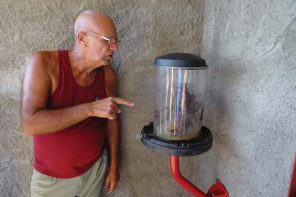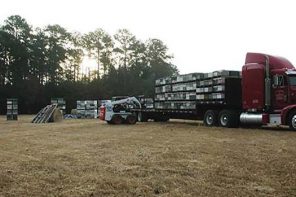By: Allen Summers
Yeah – I’ve been seeing the articles in media lately about “Murder Hornets” like you have. Think the way it’s being presented is another example of alarmism and overkill regarding seriousness to the beekeeping industry here. You probably know that I’ve seen lots of those giant hornets when I’ve been in Japan on and off for almost 25 years now. I also have a bunch of preserved specimens of queens, workers and nests.
What it gets down to in terms of real-world effects on honey bees (A. mellifera) is: 1.) They can be a threat to individual colonies if not controlled. Doubt that they would have a lot of effect on large bee yards w/lots of colonies. But need to be controlled/mitigated nonetheless so that numbers of giant hornet nests don’t increase. 2.) The established way to control for giant hornets when found and usually according to season (which is around late Summer thru Fall. Remember these are not fully eusocial vespids so their numbers increase then die-out over winter like most wasp/hornet species is to put entrance screens on hives, like robbing screens but adapted to trap giant hornets. Japanese beekeepers also go out with flyswatters and look for scout hornets and swat them down before they can go back to their nests to notify the rest of hornet colony. 3.) Finally, the nests of V. mandarinia are relatively easy to find and eradicate due to their large size conspicuous behavior aspects which is what many beekeepers do in Japan and other parts of E. Asia where they’re usually found.
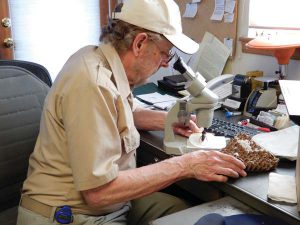
Examining specimens under dissecting
microscope.
As some of the recent articles have mentioned one has to take extra precautions when working around them or eradicating their nests. Their stings (I haven’t been stung personally but have talked with several others who have) are about a ½ cm or ¼-inch long and they can envenomate about 8 to 10 times the amount of venom as in a single Honey Bee or native hornet or wasp sting. Their venom isn’t particularly more potent than any other vespid it’s just the increased amount that causes problems for some people who get stung. Not too different than when people get stung multiple times by Africanized or just plain nasty bees. We have to be mindful here of the difference between ‘bee-sting-phobia” and real world risks from getting stung BTW.
It’s interesting that V. mandarinia queens are often handled like pets by some brave Japanese. Guess that’s because they’re top insect predators in their native habitats and in spring (when the new queens are out on initial foraging flights) they are not particularly aggressive or defensive. But like with our honey bee colonies getting into them when there’s lots of brood (to defend)..or when they are on a ‘slaughtering” rampage (mainly later in season when lots of brood to feed)..one has to take precautions not to get stung when around them. The suits they wear when working V. mandarinia nests look to me like what beekeepers wear here when working Africanized honey bees maybe a little more protective around the head and veil area (have seen some wrap thin aluminum sheets in their veils to protect from ‘sting-throughs’). They also use a lot of smoke and large smokers (like when working Africanized bees) and when getting into their nests.
Believe it or not though some Japanese also cultivate Giant Hornets for food (larvae) and they extract a regurgitated protein from the larvae called VAAM which they sell as a performance enhancer for athletes. So, they are not seen as the fearful menaces to bees and mankind that the current American media reports seem to be trying to push. They are an indigenous part of the ecosystems in many parts of E. Asia and serve a necessary function in controlling many other insect species that would otherwise cause damage to crops and agriculture. Their colloquial name over there is “Sparrow Insect” (Suzumebachi) which is definitely not an image of a foreboding insect/wasp. But people over there do respect the potential for harm if or when the proper precautions aren’t taken when working around them.
I hope that like with a lot of the sensational stuff going around in the media currently the factual situation about finding V. mandarinia in isolated places in the U.S. now can be toned-down and the doom and gloom emphasis dropped.
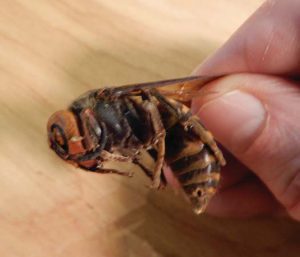
Side view of Vespa mandarinia – or “Sparrow Insect” – Suzumebachi
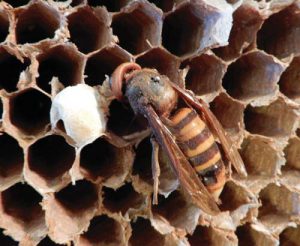
Specimen of V. mandarinia on her paper nest
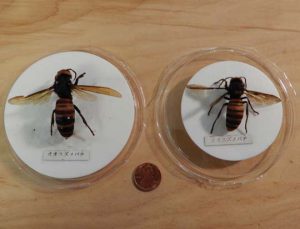
Size difference between V. mandarinia queen (left) and worker (right) – with penny to show relative size proportion.
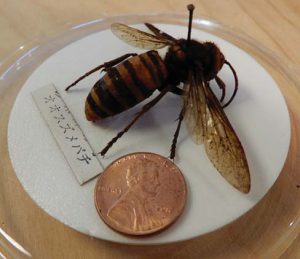
Specimen of V. mandarinia worker.
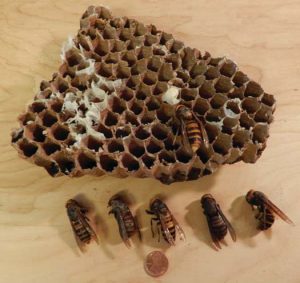
V. mandarinia workers next to V. mandarinia paper nest – with V. mandarinia queen on nest.







